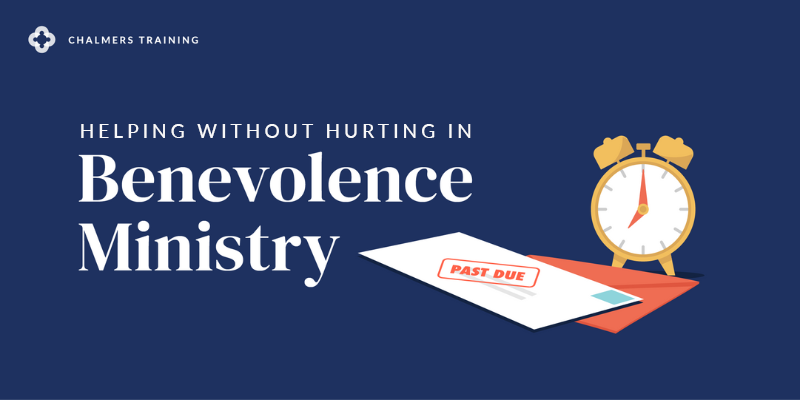Building a Transformational Benevolence Ministry
Getting into gear with a healthy benevolence ministry requires more than just good intentions or even good plans. You have to build a process to match.
One of the most important factors in a sustainable ministry model is creating a system for how you handle new requests. We call this an intake process. Having a plan that everyone follows takes the stress out of benevolence, for deacons or staff, for volunteers, and for applicants. Knowing what to say after you’ve met and introduced each other is a healthy boundary and a good gift.
Getting to Know Someone
The first time you really interact with someone who’s come to your church or organization for help can go a long way toward fostering a relationship. You want to make people feel incredibly welcome. You want to make sure they feel that you really care about the things that they’re sharing and maybe some of the pain that they’re experiencing. You need to listen well, be open, and let people come to you.
Consider including an offer of hospitality—coffee or tea, conversation—as you gather the relevant information you need to develop a plan together with an applicant (contact information, living situation, past history with the church or organization, the reason for their request, financial situation, work history, health, etc.). It doesn’t have to look like a stack of paper on a clipboard, like a doctor’s office. Be as formal or as informal as your applicants are comfortable with. If they don’t have time to go through the whole process in one sitting, invite them to come back and complete it.
You really want to discover their key problem and what they may already be doing to address it. You should start to get an idea of the factors, both internal and external, that have led to this situation. All of this information will help your church assess how best to move forward. You might find out if failure to provide emergency assistance will result in serious harm. Remember the distinction between relief, rehabilitation, and development. Some needs really require immediate assistance, and we should be careful to err on the side of mercy and generosity. Many material needs, though, are symptoms of deeper underlying issues.
You can learn a lot about a benevolence applicant’s appetite for longer-term relationship and transformative work based on how they respond to a thorough intake process. Hopefully you’ll get to know someone at a deeper level, laying the groundwork to move past a transactional moment. Let them know that trust is critical in this process and that it’s a two way street. Cultivate honesty on all sides.
Receptivity to Change
If someone can’t pay their electric bill, it may be because there’s some deeper issues going on. A good intake process will try to assess how aware someone is of that and if they are actually interested in solving larger problems than an immediate need. This gets at the issue of receptivity. If you hear people saying, “No, I don’t really have a problem, just help me with my bill and I’ll be good,” or, “Yes, I’ve got this problem, but it’s someone else’s fault” with no interest in looking further, they might not be ready to enter into a transformative ministry model.
If you find people saying, “I am tired of this, I want something different,” or “I’ve tried this and it worked/didn’t work,” you are hearing receptivity to change. You’re looking for some openness to moving forward. When someone is receptive to change, they may be ready for you to walk with them and try to take on the deeper things together.
Again, as you assess and respond to each request, remember to err on the side of grace. Don’t write anyone off too quickly. If this seems like a big hurdle, remember again, this is not a one-size-fits-all process. Our behavior and decisions need to be governed with love, wisdom and humility. It’s also not a linear process. People have families and support networks and intake is about getting context and seeing where your church fits in the big picture of someone’s life.
Making an Action Plan
If someone is initially receptive to longer-term engagement, the action plan is one of the primary tools that your church or ministry can use to walk with people as they try to move toward positive change in their lives—and the lives of their families and even their communities.
A good action plan is both asset-based and participatory. It’s about people having their own voice in transformation, not just looking at what they don’t have, but what they do. The center of development is people growing and their ability to look at their situations, make decisions for a better future, and walk through that. An action plan allows people to consider their presenting problem (financial need, family issue, etc.), and ask “Where would I like to be on this in a couple of months or next year?”
Remember, this needs to be their idea and their plan to move forward. Your role as a ministry partner is to dialogue with them and help them discover goals that are realistic and healthy. Once they’ve decided on some things to pursue, you might ask “what resources do you have that might help you get there?” Really helping people think about their social networks, their financial networks, their own personalities, and their own histories can help them identify all the assets and skills that can help them get where they want to go.
As they identify tangible steps they are prepared to take, your church or organization’s financial resources can be brought to bear to help them along the way. How valuable might it be in the long run to help someone pay for vocational training, get out of payday loan debt, or escape a bad landlord? If we only rush to meet the immediate needs people share with us, we might never find out these other ways we can help as we walk with them over time. Helping them succeed at goals they’ve formulated themselves is foundational to helping people experience positive change.
To learn more about how to craft a healthy intake process and action plan design, join us for Helping Without Hurting in Benevolence Ministry—a live, coach led training!



